Evidence from the Belgian ACE Reform - Index of
Anuncio
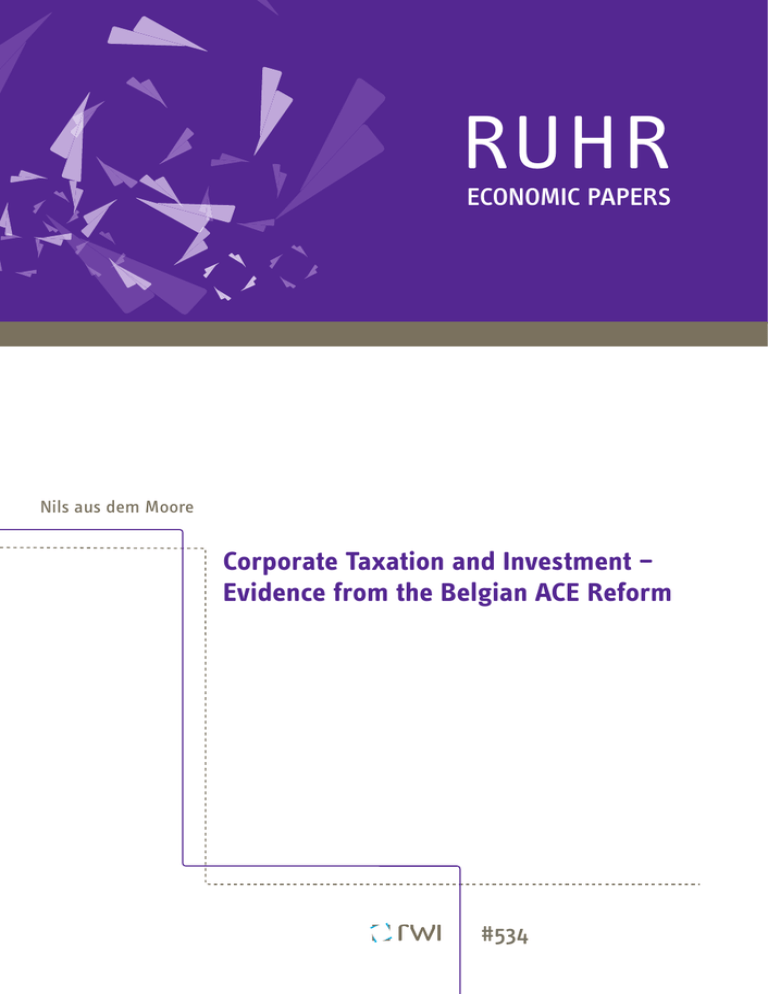
RUHR ECONOMIC PAPERS Nils aus dem Moore Corporate Taxation and Investment – Evidence from the Belgian ACE Reform #534 Imprint Ruhr Economic Papers Published by Ruhr-Universität Bochum (RUB), Department of Economics Universitätsstr. 150, 44801 Bochum, Germany Technische Universität Dortmund, Department of Economic and Social Sciences Vogelpothsweg 87, 44227 Dortmund, Germany Universität Duisburg-Essen, Department of Economics Universitätsstr. 12, 45117 Essen, Germany Rheinisch-Westfälisches Institut für Wirtschaftsforschung (RWI) Hohenzollernstr. 1-3, 45128 Essen, Germany Editors Prof. Dr. Thomas K. Bauer RUB, Department of Economics, Empirical Economics Phone: +49 (0) 234/3 22 83 41, e-mail: [email protected] Prof. Dr. Wolfgang Leininger Technische Universität Dortmund, Department of Economic and Social Sciences Economics – Microeconomics Phone: +49 (0) 231/7 55-3297, e-mail: [email protected] Prof. Dr. Volker Clausen University of Duisburg-Essen, Department of Economics International Economics Phone: +49 (0) 201/1 83-3655, e-mail: [email protected] Prof. Dr. Roland Döhrn, Prof. Dr. Manuel Frondel, Prof. Dr. Jochen Kluve RWI, Phone: +49 (0) 201/81 49 -213, e-mail: [email protected] Editorial Office Sabine Weiler RWI, Phone: +49 (0) 201/81 49 -213, e-mail: [email protected] Ruhr Economic Papers #534 Responsible Editor: Roland Döhrn All rights reserved. Bochum, Dortmund, Duisburg, Essen, Germany, 2014 ISSN 1864-4872 (online) – ISBN 978-3-86788-611-6 The working papers published in the Series constitute work in progress circulated to stimulate discussion and critical comments. Views expressed represent exclusively the authors’ own opinions and do not necessarily reflect those of the editors. Ruhr Economic Papers #534 Nils aus dem Moore Corporate Taxation and Investment – Evidence from the Belgian ACE Reform Bibliografische Informationen der Deutschen Nationalbibliothek Die Deutsche Bibliothek verzeichnet diese Publikation in der deutschen Nationalbibliografie; detaillierte bibliografische Daten sind im Internet über: http://dnb.d-nb.de abrufbar. http://dx.doi.org/10.4419/86788611 ISSN 1864-4872 (online) ISBN 978-3-86788-611-6 Nils aus dem Moore1 Corporate Taxation and Investment – Evidence from the Belgian ACE Reform Abstract We contribute to the empirical literature on the relationship between corporate taxes and investment. We exploit the introduction of the so-called ACE corporate tax reform in Belgium that came into effect in January 2006 to evaluate this relationship in a quasiexperimental setting based on firm-level accounting data. To identify the causal effect of the reform on capital spending of Belgian corporations, we focus on the indirect effect of taxes on investment via their impact on free cash-flow. We use the systematic variation of the cash-flow sensitivity of investment between small and medium versus large firms to form treatment and control groups for difference-in-differences (DiD) estimations. Our benchmark results provide highly significant and robust estimates that correspond to an increase in investment activity by small and medium-sized firms of about 3 percent in response to the ACE reform. We substantiate the robustness of our results by means of triple differences estimations (DDD) that use a matched sample of French companies as an additional dimension of contrast. JEL Classification: H25, H32, H22, G31, G38 Keywords: Corporate income taxation; investment; capital budgeting; allowance for corporate equity; difference-in-differences December 2014 1 RWI - Berlin Office. – The author is grateful to Christoph M. Schmidt, Thomas K. Bauer and Daniel Baumgarten for helpful comments and suggestions and to Anna Juschka, Marina Porto Pimentel Mendonça and Paula Schneider for research assistance. – This paper corresponds to chapter 4 of the dissertation “Myths and Measurement – Firm-level Effects of Corporate Income Taxation“ at the Faculty of Management and Economics at Ruhr-Universität Bochum, available online at http://www-brs.ub.ruhruni-bochum.de/netahtml/HSS/Diss/MooreNilsausdem/. – All correspondence to: Nils aus dem Moore, RWI - Berlin Office, Invalidenstr. 112, 10115 Berlin, Germany, e-mail: [email protected] 1 Introduction The effect of corporate taxes on investment is one of the central questions in public finance. It matters not only for the design of tax policy, but for economic growth in general (cf. Djankov, Ganser, McLiesh, Ramalho and Shleifer 2010 and the references given there). Theoretical and empirical research on the topic flourished subsequently to the pioneering contributions of Jorgenson (1963) and Jorgenson and Hall (1967). The “small selection” of Djankov et al. cites ten important studies within two decades, ranging from Summers (1981) to Desai, Foley and Hines Jr. (2004). Comprehensive surveys of this literature are provided by Auerbach (2002), Gordon and Hines Jr. (2002), Hassett and Hubbard (2002), and Hines Jr. (2007). In general, this line of applied public finance research finds negative effects of corporate income taxes on capital spending, but a widely accepted consensus estimate has yet to be established.1 Notwithstanding the prevailing differences with respect to the magnitude of estimates, the business community and many policy-makers seem to be quite convinced of the detrimental effects of corporate income taxation on capital spending, and as a result, also on economic growth and employment. We contribute to the literature by a causal evaluation of the investment effects that resulted from the introduction of an “Allowance for Corporate Equity” (ACE) in the Belgian tax system. We interpret the tax reform that came into effect in January 2006 as an economic quasi-experiment. We identify its causal impact on the capital spending of Belgian corporations by means of a difference-in-differences (DiD) approach and corroborate our findings through an additional difference-in-differences-in-differences (DDD) strategy. To identify the ACE reform effect on investment, we exploit two stylized facts on the relationship between profit taxation, corporate finance, and investment behavior: First, 1 For instance, Judd and Bauer (2006) argue that the existing empirical evidence severely underestimates the true size of the negative impact that corporate income taxes exert on the level of capital spending, since important features like imperfectly competitive markets, risk, and economic growth through innovation are usually not considered. Accounting for the interactions of these features with investment, they claim, reveals that the true economic cost of the corporate tax is much greater than commonly believed. Furthermore, Liu (2011) provides evidence for a sizeable inter-asset distortion effect of the U.S. corporate income tax system. Hence, even if capital spending does not shrink in the aggregate, the tax-induced distortions might cause sizeable production inefficiencies and potentially a significant loss in economic welfare. 4 recent evidence suggests that, aside from potential general equilibrium effects, corporate taxes impact the level of corporate investment substantially through the so called “cash flow channel”.2 Second, this channel is relevant only for small and medium-sized companies that suffer from a permanent restriction of their outside financing capacity, also known under the heading of credit rationing, but does not apply to big companies. In a three step research process, we first establish that these stylized facts apply to our dataset of Belgian manufacturing firms by means of auxiliary investment regressions. Subsequently, we exploit this structural disparity in DiD estimations that use the contrasts “small vs. big” respectively “medium vs. big” within the sample of Belgian corporations. Finally, we add a matched firm sample from France as a supplemental layer of contrast and corroborate the results from the second stage by means of a DDD regression. On this basis, we provide consistent evidence that small and medium-sized manufacturing firms in Belgium reacted to the introduction of the ACE tax reform and related tax savings from notional interest deductions with an expansion of their investment activity. Our preferred specification implies a rise of 3.7 percent for the investment rate of small firms, whereas medium-sized firms raised their investment rate by 3.0 percent. The remainder of this paper is structured as follows: Section 2 presents the institutional background of the ACE tax reform in Belgium, section 3 describes the identification strategy and the econometric models for the three stages of our analysis, section 4 gives an account of the data basis, the variables used and the results of the matching procedure, section 5 presents the results, and section 6 concludes. 2 Alternative expressions for the same fundamental relationship are “Balance Sheet Channel” and “Cash Flow Sensitivity” of corporate investment (Mizen and Vermeulen 2005, Melander 2009 and Cohn 2011). 5 2 The ACE Corporate Tax Reform in Belgium The ACE Tax reform was passed into law by the Belgian Parliament on June 22, 2005. The newly created “Deduction for Risk Capital” came into effect as from tax year 2007, i.e., for financial years ending as of December 31, 2006. The tax reform was motivated by four objectives: (i) to reduce the tax discrimination between equity and debt financing; (ii) to reinforce the attractiveness of capital intensive investments and financing; (iii) to provide an attractive environment, especially for finance companies; and (iv) to introduce a viable alternative to Belgian Coordination Centers (BCCs).3 Concerning the implementation, three fundamental rules were defined with respect to the equity base, the applicable interest rate, and the body of affected enterprises: (i) The equity to be taken into account for the calculation of the notional interest deduction is the company’s slightly corrected equity, i.e., share capital and retained earnings, at the end of the previous book year as documented in the annual accounts. (ii) The applicable interest rate is set by the government on the basis of the average interest rate on 10-year Belgian government bonds. (iii) For small and medium-sized enterprises, the notional rate is increased by 50 basis points.4 Descriptive analyses suggest that the reform achieved the aims of the government (Burggraeve, Jeanfils, Van Cauter and Van Meensel 2008). Table 1 displays an increase in the aggregate equity base by 105 billion Euro from year 2005 to 2006, the first accounting year to be booked under the new ACE tax rules. This value is considerably larger than the difference between the last two pre-reform years that amounts to 42 billion Euro. The disaggregation reveals that big firms and financing companies are responsible for the aggregate broadening of the equity base. In contrast, all small and medium-sized enterprises 3 Valenduc (2009) points out that the prime reason for the Belgian government to undertake the ACE reform was the abolishment of a preferential tax regime for financing companies that existed since 1982 under the designation of “Centres de Coordination”. In November 1998, the European Commission made clear that it regarded the BCC as a harmful tax practice that has to be terminated. Searching for a way that preserved a favorable tax situation for financing companies without violating the EU state aid rules, Belgium decided to implement the ACE tax reform. 4 In December 2011, the government implemented agreements of the European “Six Pack” by capping the ACE rate to 3 percent for the years 2012 to 2014 (3.5 percent for SMEs), whereas according to the law, the rate for 2012 would have been 4.2 percent (Adams 2012, 7). 6 (SMEs) taken together contributed a total of only 9 billion Euro. Note, however, that in relative terms, i.e., in relation to the size of their pre-existing equity base, SMEs reacted as strongly as big companies to the change of incentives that was induced by the ACE reform. The evolution of foreign direct investment suggests that the ACE reform reinforced the attractiveness for capital intensive investments (+41 billion Euro from 2005 to 2006). The ACE tax environment also attracted newly created finance companies, 5,350 alone in 2005 and 2006. Finally, the number of BCCs continued to decline after the ACE tax came into effect, but in contrast to the last pre-reform years, the parallel decline in the capital base of the remaining BCCs came to a stop. Obviously, these financing companies came to the conclusion that the notional interest deduction provided them an equally advantageous tax situation as the original preferential treatment (cf. Burggraeve et al. 2008, 21-23). Table 1: Equity Base of Belgian Companies, in Billion Euro (2004-2006) Equity 2004 2005 Non-financial corporations 2006 Δ2004 − 2005 Δ2005 − 2006 230 255 286 25 31 - Big firms 173 193 215 20 22 - SME 58 63 72 5 9 Financing companies 207 225 292 18 67 Banks and insurance companies 44 43 49 -1 7 481 523 628 42 105 Total Source: Burggraeve et al. (2008, 16) Concerning the extent and likely impact of the reform across the entire firm size spectrum, statistics from the Belgian Ministry of Finance for the fiscal year 2009 document a very uneven distribution of the ACE benefits, illustrated by figure 1. Overall, the tax and revenue office made out allowances of 17.3 billion Euro. Of this total, 32 percent were granted to a small group of only 20 companies. Reading the figure from right to left, the next group comprises 500 companies that account together for a good half of the total 7 (52 percent). In contrast, the big rest of 434,205 companies that represent 99.9 percent of the total firm population claimed only 15 percent of the ACE tax benefits. Therein, the large group of 110,000 SMEs is responsible for only 5 percent of the granted deductions. Figure 1: Interest deduction received by Belgian companies, in billion Euro, 2009 Source: Adams (2012) for the data, own illustration. 8 3 3.1 Research Design Identification Strategy The main problem in the econometric evaluation of possible investment effects of the ACE tax reform is to find a convincing estimator for the unobservable counterfactual outcome. The question to be answered is the following: How would the investment ratio of Belgian corporations have evolved in the years of the post-reform period if the tax reform had not been introduced? The first idea for an identification strategy to answer this question might be (i) to draw a suitable comparison group from a different country, (ii) to adjust for observable covariates of likely importance with respect to the outcome variable at hand by means of a propensity score matching procedure, and (iii) to estimate the causal treatment effect on the treated by means of a DiD estimation.5 In this paper, we deliberately follow a different identification strategy which enables us to circumvent the risks that are linked to the comparison of treated and non-treated firms from different countries. The opportunity to implement a DiD estimation not only as a single-country regression within Belgium, but even within the de jure treated group of Belgian corporations from the manufacturing sector, arises from two stylized facts in the empirical literature on corporate taxes and investment behavior: First, it is very hard to obtain convincing evidence for a direct tax effect on business investment, but quite easy to find evidence for an indirect effect that works through the so-called cash flow channel: Since tax payments reduce the free cash flow that might be used to finance capital spending, a rise in the corporate tax burden leads to reduced investment, all other things being equal (Mizen and Vermeulen 2005, Melander 2009, and Cohn 2011). 5 Princen (2012) followed this strategy in her brief estimation of possible investment effects of the ACE reform. We employed this approach in an accompanying paper (aus dem Moore 2014). See Imbens (2004) for a brief survey on the nonparametric estimation of average treatment effects under exogeneity and Blundell and Dias (2009) or Imbens and Wooldridge (2009) for comprehensive accounts on the econometric and statistical analysis of causal effects. 9 Second, the cash-flow sensitivity of business investment should only apply to small and medium-sized firms that often suffer from restricted access to external financing and therefore largely rely on internal funds to finance their capital spending projects. In contrast, big firms that have a long-standing track record of audited accounts and, generally, a sizeable amount of pledgeable collateral at their disposal possess a high creditworthiness and easy access to outside finance.6 Therefore, the tax-induced reduction of the fee cash flow should not matter for the extent of their capital spending as long as profitable investment opportunities exist.7 Taken together, the two stylized facts could provide the opportunity to identify the investment effect of the ACE tax reform in Belgium, based on the distinction between the de jure impact on all Belgian corporations and a likely de facto impact, with respect to the investment ratio, which can be expected to materialize only for small and medium-sized firms. Specifically, the reduction in the corporate tax burden that results from the deduction of notional equity allowances should first lead to an increase in the free cash-flow of all companies, no matter of which size. But if the second stylized fact holds, i.e., if small and medium-sized firms suffered from a restricted access to outside financing in the pre-reform period and therefore had to forgo profitable investment opportunities for lack of funds, the positive cash flow effect of the ACE reform should lead to a rise of their investment ratio. In contrast, for big firms that do no rely on the current level of free cash flow no investment effect of the ACE reform is to be expected. We propose to use this size-specific contrast within the sample of manufacturing firms as the decisive element of two difference-in-differences estimations that are based on the common distinction between pre- and post-reform years and the contrasts of “small vs. big” and “medium vs. big” manufacturing firms. To enable us to do so, we first have to establish that the two stylized facts apply to our evaluation dataset of Belgian corporations. 6 See Tirole (2006, 113-156) for an exposition of theoretical models on credit rationing and Abadie, Drukker, Herr and Imbens (2004) for cross-country empirical evidence on credit constraints, based on harmonized firm-level data for industrialized and emerging economices. 7 We abstract from possible general equilibrium effects that, if detectable at all, should not materialize in the short turn of the two post reform years. 10 3.2 Investment Regressions Since investment regressions fulfill only an auxiliary purpose in the context of our research design, namely to establish the validity of the two stylized facts for our evaluation dataset, we do not explicitly derive the details of the specification used.8 The lagged dependent variable model presented in equation 1 is a widely used standard specification (cf. Vartia 2008, 6-17 and RWI and FiFo Köln 2009, 43-65) Ii,t = α + β10 Ii,t−1 + β20 CFi,t + β21 CFi,t−1 + β30 Di,t + β31 Di,t−1 + β40 Si,t + β41 Si,t−1 + β50 Ti,t + β51 Ti,t−1 (1) + γ60 sizei,t + σ01 gdpt + σ02 gdpt−1 + λ01 yeart + λ02 μi + λ03 θi + i,t The observed investment ratio Ii,t of firm i at time t is explained by its first lag Ii,t−1 , the current value and first lag of, respectively, the cash flow ratio CFi,t , the debt ratio Di,t , the sales growth rate Si,t and the tax liability Ti,t ; as well as by economic size, the current value and the first lag of the GDP growth rate gdpt . As usual, we further include year fixed effects yeart , firm-specific effects μi , industry-specific fixed effects θi and the stochastic error term. 3.3 DiD and DDD Evaluations The econometric model for the DiD estimation of the ACE effect on the investment ratio of small, respectively medium-sized firms in Belgium, i.e., the average effect of the treatment on the treated in the counterfactual perspective of causal inference, reads as follows: (2) Ii,t = α + β Xi,t + γ smalli + λ Tt + δ ACEi,t + i,t 8 The methodological approach that we use to model the potential effect of taxes on investment relies on the user cost theory of Jorgenson and Hall (1967). In contrast to earlier static user cost models, we follow Vartia (2008, 9) and introduce dynamics by including a lagged dependent variable. 11 In equation 2, the individual investment ratio Ii,t of firm i at time t is explained by the firm characteristics with respect to the relevant covariates contained in Xi,t , the time-invariant size dummy smalli , time effects Tt , and the tax reform treatment effect ACEi,t . The latter is itself defined as an interaction term (ACEi,t = smalli ×Pt ) between an indicator for the treatment sample (i.e., smalli = 1 in the case of small firms, smalli = 0 for big firms that constitute the comparison group) and an indicator for the post-reform time period (i.e., Pt = 1 for years 2006 et seq., Pt = 0 for years until 2005). In the final step of the research process on the investment effect of the Belgian ACE tax reform, we add a matched sample of comparison firms from France as an additional dimension of contrast.9 The resulting specification for the DDD regression reads as follows: (3) Ii,j,t = α + β Xi,j,t + γ smalli + λ Tt + σ Cj + δ ACEj,t + i,j,t In equation 3, the individual investment ratio Ii,j,t of firm i in country j at time t is explained by the firm characteristics with respect to the relevant covariates contained in Xi,j,t , the time-invariant size dummy smalli , the time-invariant country dummy Cj , country-invariant time effects Tt , and the tax reform treatment effect ACEi,j,t . The latter is itself defined as an interaction term (ACEi,j,t = smalli ×Cj ×Pt ) between an indicator for the size group (i.e., smalli = 1 in the case of small firms, smalli = 0 for big firms that constitute the comparison group), the country dummy (i.e., Cj = 1 in the case of a Belgian firm, Ci = 0 in the case of a French firm), and an indicator for the post-reform time period (i.e., Pt = 1 for the years 2006 et seq., Pt = 0 for years until 2005). 9 France is in many economic aspects very similar to Belgium and on a variety of grounds a suitable reservoir to draw a comparison group. Most important in our context is the fact that the corporate tax rate in France was constant during the period from 2000 to 2008, at 33.33%. Time-varying adjustments of a small surcharge had only minor effects on the overall corporate tax rate. For details, see the “CBT tax database” that is provided online by the Oxford University Centre for Business Taxation at http://www.sbs.ox.ac.uk/ideas-impact/tax/publications/data. We verified via graphical analysis that the common trend assumption is not violated. The evolution of the investment ratio (median values) of small, medium-sized and big firms of the manufacturing sector in Belgium and France is documented in Figure 3 in the appendix. 12 4 4.1 Data, Variables, Matching Data and Variables The empirical analysis is mainly based on the pan-European database AMADEUS, compiled by the Bureau van Dijk (BvD). It contains detailed accounting information on more than 10 million companies from 41 countries, spanning the member states of the EU and Eastern Europe. A standard company report includes 24 balance sheet items, 26 ratios, 25 profit and loss items and descriptive information including trade descriptions and activity codes. The data used in this paper stem from the AMADEUS updates #124 (January 2005) and #202 (January 2011). Since every compilation covers about ten years backwards, there is a considerable overlap of the two updates. For every update, quality inspections and data revisions by BvD focus on the year of compilation and the previous 3 to 5 years. Therefore, the dataset used in the estimations was constructed by means of a merging procedure that exploited the existing overlap to fill gaps in the newer update with information from the older one, wherever this enhancement of overall data quality was feasible. Given that the research aim of the present paper is to investigate possible investment effects of the Belgian ACE tax reform, the dataset is limited to the sector with the highest capital intensity and corresponding investment levels, i.e., manufacturing.10 The time span of the dataset is restricted to the years from 2000 to 2008. Nine years of observations should provide a sufficient length for the dynamic panel data models that were estimated in stage one of the analysis. Three post-reform years were included, i.e., 2006, 2007 and 2008, to account for possible lead times of bigger investment projects in the post-reform period.11 10 The resulting starting basis prior to the subsequent steps of data processing is documented in the appendix by tables 8 for Belgium and table 9 for France. 11 Admittedly, the inclusion of the year 2008 that witnessed the escalation of the U.S. financial crisis to the second global economic depression could be regarded as a questionable choice. However, associated risks with respect to the validity of the identification strategy are very limited: If the financial crisis that reached the “real” economy in Europe not until the collapse of Lehman Brothers on September 15th already exerted a sizeable investment effect with respect to the annualized values of accounting year 2008, it surely materialized as a decline of the investment ratio. Hence, our estimated investment effect of the ACE tax reform is potentially biased downwards, clearly the lesser of two evils. Since this argument does not apply with respect to the evaluation of ACE effects on the leverage ratio, where the tax reform and 13 Several additional steps of data selection and processing are undertaken: First, since we evaluate a corporate tax reform, we restrict the sample to companies of the corporate sector. Second, to identify the reform effect without confounding influences from (multior international) group or holding structures, we only keep companies for which unconsolidated accounting data are available. Third, we exclude all companies that are defined as “micro” by the European Commission (2003) since they were also excluded from the benefits of the ACE equity tax shield. Finally, observations with clear data errors and likely outliers were dropped.12 As a covariate that controls for country specific influences on a macroeconomic level in the final stage of DDD estimation, the respective GDP growth rates for Belgium and France were added. This information is taken from the database OECDStat. Category variables are defined to allow for split-sample analyses by firm size group. Finally, industry dummy variables differentiate groups of economic activities on the two-digit level of NACE Rev. 2. The variables used in evaluating the investment effects of the Belgian ACE tax reform are defined and constructed as follows: • Investment ratio is the ratio of investment to total assets. It was calculated as the difference between the fixed asset value in the balance sheet of two consecutive years in relation to the balance sheet total. • Sales growth is the ratio of the change in sales over shareholder funds. • Cash flow ratio is the ratio of cash flow over shareholder funds. • Debt ratio is the ratio of total debt over shareholder funds. the impact of the financial crisis are expected to work in the same direction, we excluded the year 2008 from the analysis in the accompanying paper (aus dem Moore 2014). 12 Concretely, we first dropped all observations with negative values for fixed assets or turnover. We then applied the two-step cleanup procedure of RWI and FiFo Köln (2009, 48-49) and dropped firm-year observations (i) if the absolute value of sales growth, investment ratio or cash flow was larger than three and (ii) if the year-on-year rate of change in these variables was outside of the 5th and 95th percentiles of the respective distribution. Hence, in the case of Belgium, the sample size decreased from originally 69,172 observations to 56,032 observations, i.e., by 13,140 observations or by 19 percent. For France, the sample size was reduced from 186,736 to 148,750 observations, i.e., by 37,986 observations or by 20 percent. 14 • Tax is the accounting item for the tax liability that consists, in the case of corporations, almost exclusively of corporate income tax. • Size is defined here in a financial sense as the natural logarithm of total assets. • GDP growth rate is the annual percentage rate of change in aggregate national GDP as defined and provided by the OECD. • Industry dummies are defined at the two-digit level of economic activities in accordance with NACE Rev. 2. • Size dummies for the three categories of small, medium and big firms follow the approach of European Commission (2003).13 4.2 Matching The propensity score estimation to match the samples of treated and untreated observations with respect to all relevant and observable characteristics was carried out on the basis of data for the year 2004 to insulate the estimates from conceivable anticipation effects by Belgian firms. As the first step of the matching procedure, the propensity score is estimated by means of a probit model based on the variables that potentially determine the investment ratio. Thus, the set of independent variables consists of the cash flow ratio, the debt ratio, sales growth and size as defined above. Furthermore, industry dummies at the two-digit level are included in the probit regressions to pair firms from Belgium and France that pursue the same kind of economic activity. As a result of this estimation, the relevant information contained in these variables is compressed into a single index, the propensity score.14 We used the estimated propensity scores to match treatment observations from Belgium with similar control observations from France. Given that the French sample size is con13 The dummy variables for the three size categories small, medium and big are based on averages over the whole time span, i.e., firms do not change their size class over time. 14 Since we are only interested in obtaining the propensity score estimates as a matching tool, we skipped the detailed presentation and discussion of the output from the preparatory probit regression. These results are documented in table 10 in the appendix. 15 Figure 2: Common Support for Belgium and France siderably larger than the one for Belgium, we applied a basic nearest neighbor matching with only one match per treatment oberservation and no replacement. As recommended by Leuven and Sianesi (2011), the matching routine was forced to drop all treatment observations from Belgium that were off the common support.15 The result of the matching procedure is illustrated by figure 2. It shows that the common support reaches across a wide range of propensity score values. A detailed account of the balancing quality in the matched sample is documented in table 2. The aim of stratifying a sample in which treated and control observations are virtually identical with respect to the decisive covariates is fully achieved: For cash flow, debt, sales growth, and size, the matched sample displays no significant differences in the means of treated and control observations. Table 3 summarizes the descriptive statistics of the dataset that resulted from the matching procedure. The matrix format corresponds to the DID and DDD estimations that 15 From a total of 3,802 Belgian observations in the year 2004, 1,742 (45.8%) were on the support, whereas 2,060 (54,18%) were off the support. 16 Table 2: Belgium and France - Results of Propensity Score Matching Variable Cash Flow Debt Sales Growth Size Treated Control % Diff. Unmatched Matched 0.11213 0.11202 0.09751 0.10861 18.2 4.2 Unmatched Matched 0.22901 0.22861 0.15958 0.22165 Unmatched Matched 0.07478 0.07497 Unmatched Matched 9.4362 9.4338 % Diff. Reduction t p>|t| 76.7 7.45 1.17 0.000 0.244 40.8 4.1 90.0 17.07 1.09 0.000 0.277 0.08166 0.07451 -5.2 0.4 93.2 -2.05 0.11 0.041 0.916 8.8934 9.4794 42.9 -3.6 91.6 16.58 -0.95 0.000 0.344 are discussed in the following section. Panel A at the top contains mean values (and associated standard deviations in parentheses below) for Belgium and France in the prereform period from 2000 to 2005, in each case with separated columns for the three firm size groups small, medium and big. Likewise, panel B at the bottom summarizes the respective information for the post-reform period from 2006 to 2008. 17 Table 3: Belgium and France - Descriptive Statistics, Matched Sample (2000-2008) A. Pre-period 2000-2005 Belgium Variable France Small Medium Big Small Medium Big Investment 0.019 (0.142) 0.025 (0.142) 0.040 (0.196) 0.014 (0.067) 0.067 (1.961) 2.598 (66.232) Cash Flow 0.117 (0.096) 0.209 (0.175) 0.060 (0.203) 120.037 (171.500) 8.466 (0.462) 1.983 (1.134) 0.114 (0.090) 0.246 (0.228) 0.076 (0.221) 357.759 (499.441) 9.697 (0.515) 2.003 (1.131) 0.112 (0.093) 0.299 (0.230) 0.068 (0.204) 2548.809 (7594.574) 11.613 (1.106) 2.022 (1.133) 0.110 (0.081) 0.207 (0.181) 0.066 (0.127) 97.361 (130.306) 8.259 (0.535) 1.751 (0.864) 0.091 (0.504) 0.214 (0.185) 0.064 (0.121) 415.125 (590.870) 9.774 (0.558) 1.686 (0.815) 0.441 (8.943) 0.241 (0.184) 0.064 (0.115) 6346.855 (28147.740) 11.845 (1.174) 1.692 (0.822) 3,866 2,462 1,253 3,869 1,933 1,575 Debt Sales Growth Tax Size GDP Growth Rate Number of observations B. Post-period 2006-2008 Belgium Variable France Small Medium Big Small Medium Big Investment 0.021 (0.081) 0.018 (0.077) 0.025 (0.093) 0.013 (0.058) 0.020 (0.063) 0.027 (0.064) Cash Flow 0.117 (0.089) 0.202 (0.169) 0.089 (0.136) 160.731 (236.838) 8.739 (0.513) 2.145 (0.908) 0.108 (0.088) 0.215 (0.185) 0.082 (0.140) 438.519 (932.047) 9.954 (0.509) 2.133 (0.912) 0.109 (0.109) 0.269 (0.235) 0.085 (0.122) 3011.349 (6357.485) 11.943 (1.118) 1.118 (1.118) 0.101 (0.072) 0.178 (0.146) 0.077 (0.120) 119.240 (173.676) 8.506 (0.499) 1.568 (1.259) 0.095 (0.082) 0.179 (0.162) 0.077 (0.116) 526.965 (718.885) 10.026 (0.463) 1.560 (1.261) 0.092 (0.080) 0.222 (0.181) 0.074 (0.112) 5583.585 (16045.710) 12.068 (1.060) 1.586 (1.256) 2,079 1,425 671 2,129 1,162 932 Debt Sales Growth Tax Size GDP Growth Rate Number of observations Note: Data from Amadeus (BvD), updates #124 and #202. 18 5 Results 5.1 Investment Regressions Table 4 and table 5 report the results from the first-stage investment regressions, respectively for the full sample of Belgian manufacturing companies (Table 4), and separated by different firm size groups (Table 5). We estimated the dynamic regression equation separately by pooled Ordinary Least Squares (OLS), by Fixed Effects (FE), and by the “Difference” and “System” variants of the General Methods of Moments estimator (GMM). Since the latter estimators are more appropriate in the context of a dynamic panel data estimation with a lagged dependent variable16 , we will focus our interpretation mostly on the results that were obtained in GMM estimations. Turning first to the full sample results, the overall cash-flow sensitivity of investment in the manufacturing sector is clearly established across the alternative estimation techniques that are reported in columns (1) to (4). The current cash flow is highly significant in all estimations. The first lag is also significantly positive in columns (2) to (4), since the corresponding estimation techniques are, in contrast to pooled OLS, able to use the time series information at the level of the individual firm.17 Coefficients for the other right-hand side variables are either insignificant or estimated with the “correct” sign with respect to theoretical predictions and prior evidence. Higher debt levels lead, all other things being equal, to lower investment, since funding opportunities have already been used to a large extent in preceding years. Size displays a significant coefficient in the OLS and FE estimations reported in columns (1) and (2), but turns insignificant in the GMM columns (3) and (4). Note that the tax liability estimate is only statistically significant in the OLS estimation (though with a clearly irrelevant coefficient size in economic terms), but insignificant in the more meaningful estimations in columns (2) to (4). Hence, our conjecture seems to be substantiated that corporate tax payments do not matter for the size of business investment in a direct way but indirectly 16 Cf. Wooldridge 2001, Bond 2002, Baum 2006, and Roodman 2009. Therefore, results obtained by these techniques are of considerably higher relevance in dynamic panel data estimation than those from pooled OLS regressions. 17 19 Table 4: Cash Flow Effect on Investment, Manufacturing (1) (2) (3) (4) Dependent Variable: Investment OLS FE GMM (Difference) GMM (System) Investment (first lag) -0.176*** -0.337*** -0.319*** -0.319*** (0.0197) 0.0967*** (0.0313) 0.00383 (0.0258) 0.0490*** (0.0164) -0.0352** (0.0160) 0.0339*** (0.0101) 0.0213** (0.00901) -2.32e-06*** (8.79e-07) 1.64e-06*** (5.93e-07) 0.0116*** (0.00161) 0.000852 (0.00267) 0.00415* (0.00252) (0.0113) 0.155*** (0.0260) 0.114*** (0.0254) -0.0510*** (0.0154) -0.0568*** (0.0148) -0.00400 (0.00865) -0.0153* (0.00793) -1.06e-07 (1.07e-06) 1.49e-06 (1.31e-06) 0.173*** (0.00761) 0.00144 (0.00196) 0.00434** (0.00185) (0.0379) 0.990** (0.388) 1.250*** (0.313) 0.397 (0.247) -0.578*** (0.224) -0.196 (0.191) -0.220 (0.148) -6.31e-06 (2.23e-05) -9.56e-06 (2.60e-05) 0.0465 (0.178) -0.00542 (0.00976) -0.0210 (0.0254) (0.0379) 0.990** (0.388) 1.250*** (0.312) 0.397 (0.247) -0.578*** (0.224) -0.196 (0.191) -0.220 (0.148) -6.31e-06 (2.23e-05) -9.56e-06 (2.60e-05) 0.0465 (0.178) -0.00542 (0.00976) -0.0210 (0.0254) R2 0.066 0.222 Observations Groups Instruments AR(1) p-value AR(2) p-value Hansen p-value 7221 7221 2009 5496 1594 73 0.000 0.335 0.018 7221 2009 83 0.000 0.844 0.048 Cash Flow Cash Flow (first lag) Debt (first lag) Debt (second lag) Sales Growth Sales Growth (first lag) Tax Tax (first lag) Size GDP Growth Rate GDP Growth Rate (first lag) Notes: (i) Year and industry dummies and a constant term are included in all estimates. (ii) Robust standard errors are reported in parentheses. (iii) * Significant at 10%, ** at 5%, *** at 1%. through the diminishing effect they exert on the size of the cash flow. Overall, we note as the most important finding from table 4 that cash flow size obviously matters strongly for the extent of business investment at the aggregate level of the full sample.18 18 We skipped a detailed discussion of the statistical quality of the GMM estimations for two reasons: First, the estimate for the lagged dependent variable is clearly within the bounds of OLS and FE for both GMM estimators. Second, it is no cause of concern that the Hansen p-value in both GMM columns 20 Table 5: Cash Flow Effect on Investment, Manufacturing, by Size (1) (2) (3) (4) ALL SMALL MEDIUM BIG Dependent Variable: Investment GMM (System) GMM (System) GMM (System) GMM (System) Investment (first lag) -0.319*** (0.0379) -0.356*** (0.0578) -0.207*** (0.0522) -0.291*** (0.0518) Cash Flow 0.990** (0.0313) 1.250*** (0.312) 0.397 (0.247) -0.578*** (0.224) -0.196 (0.191) -0.220 (0.148) -6.31e-06 (2.23e-05) -9.56e-06 (2.60e-05) 0.0465 (0.178) -0.00542 (0.00976) -0.0210 (0.0254) 1.199*** (0.0260) 1.124*** (0.393) 0.481 (0.299) -0.0396 (0.210) 0.343* (0.190) 0.152 (0.147) -0.000462** (0.000186) -4.63e-05 (0.000230) 0.253 (0.181) 0.00330 (0.0137) -0.0372 (0.0263) 1.979*** (0.388) 0.830*** (0.312) 0.279 (0.226) 0.0316 (0.238) -0.0358 (0.134) -0.0367 (0.116) -0.000188*** (4.99e-05) -3.67e-05 (7.45e-05) 0.162 (0.158) -0.00638 (0.0114) -0.0249 (0.0303) -0.0223 (0.388) 0.214 (0.226) -0.108 (0.162) -0.235* (0.129) -0.203 (0.195) -0.206 (0.135) 3.95e-06 (9.78e-06) 8.29e-06 (9.03e-06) 0.227 (0.158) 0.0120 (0.0134) -0.0492* (0.0272) 7221 2009 83 0.000 0.844 0.048 3707 1048 83 0.299 0.942 0.036 2346 650 83 0.070 0.464 0.697 1168 311 83 0.601 0.065 0.289 By Size Group: Cash Flow (first lag) Debt (first lag) Debt (second lag) Sales Growth Sales Growth (first lag) Tax Tax (first lag) Size GDP Growth Rate GDP Growth Rate (first lag) Observations Groups Instruments AR(1) p-value AR(2) p-value Hansen p-value Notes: (i) Year and industry dummies and a constant term are included in all estimates. (ii) Robust standard errors are reported in parentheses. (iii) * Significant at 10%, ** at 5%, *** at 1%. The results for the split-sample analyses by firm size group, documented in table 5 for our preferred “System” GMM estimations, confirm the theoretical prediction that the cash signals an unsatisfactory quality of the internal instruments, since the trustworthy FE estimation is by itself sufficient to establish the result of an existing cash-flow sensitivity at the aggregate level of the manufacturing sector in Belgium. 21 flow dependency of business investment should be restricted to capital constrained firms of small and medium size, but not apply to big firms that have easy access to outside funds for the financing of investment opportunities.19 The result of a size-dependent cash flow effect on business investment confirms that our basic idea for identification of the investment effect from the ACE tax reform seems to be valid: Since the cash flow sensitivitiy of investment is confined to small and medium-sized firms in the Belgian manufacturing sector, but does not apply to big firms, we can exploit this structural contrast to implement a difference-in-differences estimation on the basis of the Belgian sample. These results are presented in the next subsection. 5.2 Difference-in-Differences Evaluation (DiD) Table 6 presents the results from both variants of the difference-in-differences estimation within Belgium: Panel A on the left contains the estimates from the DiD regression that was based on the double contrast between small and big firms in the pre- and post-reform periods, panel B on the right side displays the corresponding results for the DiD regression that differentiated between medium and big firms before and after the coming into effect of the ACE tax reform. The DID indicator is implemented via the term ACE as the interation small × post in panel A and as the interaction medium × post in panel B. Each case was estimated twice, by OLS and FE, as documented in the respective column heading.20 In panel A, the ACE indicator signals strong evidence for a sizeable and positive investment effect of the tax reform in the case of small companies: The OLS estimate implies a 2.5 percent increase of their investment ratio in the post-reform period, while the FE estimate translates to a positive effect of 3.1 percent. Both estimates are highly signifi19 The full results that include qualitatively identical estimates from the corresponding OLS, FE and “Difference” GMM regressions are available from the author upon request. 20 The available time span is too short to produce satisfactory GMM estimates. Since we are not interested in maximal precision of the estimates for the covariates, but in a reliable estimate of the DiD effect, the OLS and FE regressions should be entirely sufficient. As argued above, the FE estimates are more meaningful in the given context, corroborated by the higher values of R2 in columns (2) and (4) as compared with columns (1) and (3). 22 Table 6: DiD Evaluation of the ACE Reform Effect on Investment (1) Dependent variable: Investment (2) (3) (4) A. Small vs. Big B. Medium vs. Big OLS FE OLS FE 0.0340*** (0.0116) 0.0129 (0.0113) 0.0250*** (0.00341) -0.00133 (0.00433) 0.0505*** (0.0107) -0.0241** (0.0105) 0.0250*** (0.00809) 0.0173* (0.00980) -0.0621*** (0.0202) 0.197*** (0.0105) 0.000169 (0.00283) -0.0146 (0.0122) -0.0359 (0.0231) 0.171*** (0.0122) 0.000769 (0.00390) -0.0918*** (0.0104) 0.0309*** (0.00938) 0.00234 (0.0129) 0.0278 (0.0169) 0.0203*** (0.00363) -0.000399 (0.00572) 0.0243*** (0.00838) -0.0320*** (0.0115) 0.0123 (0.00849) -0.0924*** (0.0127) 0.0202* (0.0110) R2 0.040 0.108 0.036 0.096 Observations Groups 4398 4398 1084 3225 3225 824 Sales Growth (first lag) Debt (first lag) Size GDP Growth Rate Small(A)/Medium(B) (Dummy) Post (Dummy) ACE Notes: (i) Year and industry dummies and a constant term are included in all estimates. (ii) Robust standard errors are reported in parentheses. (iii) * Significant at 10%, ** at 5%, *** at 1%. cant at the 1 percent level. In panel B, the results for the ACE indicator in the case of medium-sized firms are of rather suggestive nature: The OLS estimate of a 1.2 percent increase is not significant, and the FE estimate of a rise by 2.0 percent is significant only at the 10 percent level. The revealed effect heterogeneity is in line with prior evidence showing that the cash-flow sensitivity of business investment is more pronounced for small firms (that basically all suffer from the underlying financing restriction, cf. Tirole 2006) than for medium-sized firms (that are an intermediate category composed of capital-restricted and non-restricted firms to varying degrees, depending for instance on the sector of economic activity and the depth of the surrounding financial market, cf. Mizen and Vermeulen 2005). 23 5.3 Triple Differences Evaluation (DDD) Compared to the DiD estimation discussed above, the DDD evaluation adds the matched sample of comparison firms from France as an additional dimension of contrast. Why might this be useful, given that the preceding DiD evaluation rests on a sound identification strategy and points convincingly towards a positive ACE reform effect on investment? The reason is that, so far, we cannot exclude that the size-dependent investment effect which we tend to ascribe to the ACE reform does not result from a simultaneous trigger beyond Belgian (tax) policy. If, for example, a special support scheme for the financing of small and medium-sized companies in Europe or the like was enacted at the same time, such a policy instrument could be the real cause behind the observed investment effects. Hence, the supplementary DDD evaluation is driven by the motive to safeguard the interpretation of our DiD analysis against such a fallacy. If a similar size-related investment response is observed for France, where no ACE reform was enacted but any support scheme of the European Union would presumably materialize pretty much in the same way as in Belgium, the DDD evaluation would not reveal a significant reform effect. Thereby, it would debunk the invalidity of the identification strategy behind our prior DiD evaluation. On the other hand, a significantly positive outcome of the DDD evaluation would further corroborate the findings from the preceding DiD analysis. Table 7 presents the results from this final stage of our research process on the investment effects of the Belgian ACE tax reform. The table layout is unchanged: Panel A contains the estimates from the DDD regression that was based on the triple contrast between small and big firms, “Belgium vs. France” and “pre vs. post”. Panel B on the right side displays the corresponding results for the DDD regression that differentiated between medium and big firms and the contrasts “Belgium vs. France” and “pre vs. post”. The DiD indicator is implemented via the term ACE, defined as the interation small×post×Belgium in panel A and as the interaction medium×post×Belgium in panel B, respectively. Again, each case was estimated by OLS and FE as documented in the respective column heading. 24 Table 7: DDD Evaluation of the ACE Reform Effect on Investment (1) Dependent variable: Investment (2) (3) (4) A. Small vs. Big B. Medium vs. Big OLS FE OLS FE 0.0372*** (0.00837) -0.00261 (0.00663) 0.0124*** (0.00169) 0.00427 (0.00472) 0.0171** (0.00686) 0.0338*** (0.00693) 0.000912 (0.00874) -0.0229*** (0.00728) -0.00615 (0.00448) -0.0249*** (0.00818) 0.0321*** (0.00922) 0.0153** (0.00656) -0.0791*** (0.0116) 0.131*** (0.00607) 0.00602 (0.00407) -0.0142* (0.00851) -0.0462*** (0.0144) 0.00602 (0.00567) 0.138*** (0.00786) -0.00608 (0.00613) -0.0316*** (0.00823) 0.0369*** (0.00964) 0.00650 (0.0100) 0.00909 (0.0100) -0.000458 (0.00669) 0.0102*** (0.00189) 0.0167** (0.00696) 0.0202*** (0.00538) -0.00654 (0.0127) -0.0164** (0.00767) -0.00924* (0.00512) -0.0241*** (0.00816) 0.0218** (0.00991) R2 0.026 0.073 0.021 0.074 Observations Groups 9604 9604 2328 6531 6531 1646 Sales Growth (first lag) Debt (first lag) Size GDP Growth Rate Belgium Small(A)/Medium(B) (Dummy) Post (Dummy) Belgium x Small(A)/Medium(B) Small(A)/Medium(B) x Post Belgium x Post ACE -0.0379*** (0.00978) -0.0493*** (0.0130) -0.00955 (0.00777) -0.0320*** (0.00916) 0.0300** (0.0117) Notes: (i) Year and industry dummies and a constant term are included in all estimates. (ii) Robust standard errors are reported in parentheses. (iii) * Significant at 10%, ** at 5%, *** at 1%. In panel A, the small firm results from the DiD evaluation are confirmed: the DDD estimate from the OLS regression implies a positive investment effect for small firms of 3.2 percent; the FE estimate translates to a rise in the investment ratio of 3.7 percent. Both coefficients are significant at the 1 percent level. Compared to the DiD estimates from above, the size of the estimates rises slightly (OLS: +71 basis points, FE: +60 basis points) and the precision of the ACE estimation increased, documented by a narrowing gap between the respective values of OLS and FE estimates (DiD: 59 basis points, DDD: 48 basis points). Thus, the DiD result is not only confirmed, but even substan- 25 tiated by the DDD regression. Therefore, the DDD estimation can also be regarded as a robustness check on the validity of the identification assumptions that are required for the preceding DiD estimation.21 Panel B documents that the addition of the matched firm sample from France as a supplemental layer of contrast enabled the DDD regression to produce an additional result: OLS and FE estimations both display positive ACE estimates that are significant at the 5 percent level. The OLS result implies an increase of 2.2 percent, whereas the FE estimate translates to a rise of the investment ratio of 3.0 percent. Hence, the final step of our research strategy leads to a clear evaluation result that is consistent with the structural contrast pattern that was identified in the investment regressions at the initial stage: Small and medium-sized manufacturing firms in Belgium, for which the cash-flow sensitivity of investment is empirically assured, seemingly reacted to the introduction of the ACE tax reform and the related tax savings from notional interest deductions with an expansion of their investment activity. Based on the more relevant results from the fixed effects DDD regressions, the investment rate of small firms increases by approximately 3.7 percent, whereas medium-sized firms raised their investment rate by 3.0 percent. However, we note the seeming contradiction that those firm size groups display a sizeable and significant investment effect, who claimed only a very small proportion of the granted ACE deductions, at least in the year 2009 as illustrated by figure 1. In the discussion of table 1, we already pointed to the fact that in relative terms, i.e., in relation to the size of their pre-existing equity base, SMEs reacted as strongly as big companies to the change of incentives that was induced by the ACE reform. In view of this fact, a significant investment effect of SMEs seems quite plausible. Four additional factors might have also played a role: (i) The observed investment effect for SMEs could partly be of institutional nature, since the ACE introduction was 21 Against this backdrop and in the interest compactness, we do not present in a separate subsection the bulk of less meaningful robustness checks that were executed (e.g., using datasets that resulted from alternative cutt-off thresholds in the early data processing, using matched datasets that resulted from slightly different propensity score estimation routines, variations in the length of pre- and post-reform periods et cetera). 26 accompanied by several special provisions targeted at small and medium-sized firms, see Valenduc (2009). (ii) An economic supply side effect might also play a role: Since big firms reduced their leverage ratio, the supply of credit to small and medium-sized firms likely increased, and/or credit costs declined. Thus, reduced financing costs for small and medium-sized enterprises could also translate into a higher investment ratio. (iii) Furthermore, an economic trickle-down effect could be at work: Since big firms profited hugely from the ACE introduction, the improvement of their economic situation might benefit also small and medium-sized firms (e.g., via a higher order volume of pre-products). (iv) Finally, a general improvement of the economic sentiment, due to the widespread expectation of beneficial effects of the ACE introduction, might also have served as a kind of psychological boost for small and medium-sized firms. 27 6 Conclusion Empirical research in public finance has had difficulties to establish the exact size and nature of the relationship between corporate taxes and investment, despite the widely held belief in theory and practice that taxes do matter for capital spending. In this paper, we exploit the introduction of the ACE in Belgium to evaluate this relationship in a quasiexperimental setting. We use an original identification strategy that focuses on the indirect effect of taxes on investment via their impact on free cash-flow as a major determinant of investment. We use the systematic variation of the cash-flow sensitivity between small and medium versus large firms to form treatment and control groups for a difference-indifferences (DiD) estimation. Our benchmark results provide highly significant and robust estimates that correspond to an increase in investment activity by small and medium-sized firms of about 3 percent in response to the ACE reform. We further substantiate the robustness of our results by providing results from a triple differences estimation (DDD) that uses a matched sample of French companies as an additional dimension of contrast. 28 References Abadie, Alberto, David Drukker, Jane L. Herr, and Guido W. Imbens, “Implementing Matching Estimators for Average Treatment Effects in Stata,” The Stata Journal, 2004, 4 (3), 290–311. Adams, Bart, “Abzug für Risikokapital (Fiktiver Zinsabzug) - Der belgische Weg zu mehr Eigenkapitalbildung,” Presentation given at “Die Deiche jetzt bauen - Eigenkapitalkongress der Familienunternehmer”, June 6, Berlin, 2012. Auerbach, Alan J., “Taxation and Corporate Financial Policy,” in Alan J. Auerbach and Martin Feldstein, eds., Handbook of Public Economics, Vol. 3 2002, chapter 19, pp. 1251–1292. aus dem Moore, Nils, “Taxes and Corporate Financing Decisions - Evidence from the Belgian ACE Reform,” Ruhr Economic Papers #533, 2014. Baum, Christopher F., An Introduction to Modern Econometrics Using Stata, Stata Press, 2006. Blundell, Richard and Monica Costa Dias, “Alternative Approaches to Evaluation in Empirical Microeconomics,” Journal of Human Resources, 2009, 44 (3), 227–251. Bond, Stephen R., “Dynamic Panel Data Models: A Guide to Micro Data Methods and Practice,” Institute for Fiscal Studies, CEMMAP Working Paper CWP 09/02, 2002. Burggraeve, Koen, Philippe Jeanfils, Kris Van Cauter, and Luc Van Meensel, “Impact Macroéconomique et Budgétaire de la Déduction Fiscale pour Capital à Risque,” Revue économique, 2008, Septembre, 7–49. Cohn, Jonathan B., “Corporate Taxes and Investment: The Cash Flow Channel,” Mimeo. Available online at: http://www2.mccombs.utexas.edu/faculty/jonathan. cohn/papers/nols%20-%20jan%202011.pdf, January 2011. Desai, Mihir A., C. Fritz Foley, and James R. Hines Jr., “A Multinational Perspective on Capital Structure Choice and Internal Capital Markets,” The Journal Of Finance, 2004, 59 (6), 2451–2487. Djankov, Simeon, Tim Ganser, Caralee McLiesh, Rita Ramalho, and Andrei Shleifer, “The Effect of Corporate Taxes on Investment and Entrepreneurship,” American Economic Journal: Macroeconomics, 2010, 2 (3), 31–64. 29 European Commission, “Commission recommendation of 6 May 2003 concerning the definition of micro, small and medium-sized enterprises,” Official Journal of the European Commission, 2003/361/EC, Brussels, 2003. Gordon, Roger H. and James R. Hines Jr., “International Taxation,” in Alan J. Auerbach and Martin Feldstein, eds., Handbook of Public Economics, Vol. 4 2002, pp. 1935–1995. Hassett, Kevin A. and R. Glenn Hubbard, “Tax Policy and Business Investment,” in Alan J. Auerbach and Martin Feldstein, eds., Handbook of Public Economics, Vol. 4 2002, pp. 1293–1343. Hines Jr., J. R., “Corporate Taxation and International Competition,” in A. J. Auerbach, J. R. Hines Jr., and J. Slemrod, eds., Taxing Corporate Income in the 21st Century, Cambridge: Cambridge University Press, 2007, pp. 268–295. Imbens, Guido W., “Nonparametric Estimation of Average Treatment Effects Under Exogeneity: A Review,” The Review of Economics and Statistics, February 2004, 86 (1), 4–29. and Jeffrey M. Wooldridge, “Recent Developments in the Econometrics of Program Evaluation,” Journal of Economic Literature, 2009, 47 (1), 5–86. Jorgenson, Dale, “Capital Theory and Investment Behavior,” American Economic Review, 1963, 53, 247–259. and Robert E. Hall, “Tax Policy and Investment Behavior,” American Economic Review, 1967, 57, 391–414. Reprinted in Bobbs-Merrill Reprint Series in Economics , Econ-130. Investment 2, ch. 1, pp 1-26. Judd, Kenneth L. and Paul H. Bauer, “Corporate Income Taxation in a Modern Economy,” Paper prepared for the Conference “Corporate Income Taxation and the Economy”, American Enterprise Institute (AEI), Washington D.C., June 1, 2006. Leuven, Edwin and Barbara Sianesi, “PSMATCH2: Stata Module to Perform Full Mahalanobis and Propensity Score Matching, Common Support Graphing, and Covariate Imbalance Testing,” available online: http://ideas.repec.org/c/boc/bocode/ s432001.html, Version: 4.0.6 (17.05.2012), 2011. Liu, Li, “Do Taxes Distort Corporations‘ Investment Choices? Evidence from IndustryLevel Data,” Working Paper, October 2011, Oxford University Centre for Business Taxation, 2011. 30 Melander, Ola, “The Effect of Cash Flow on Investment: An Empirical Test of the Balance Sheet Channel,” Sveriges Riksbank (Central Bank of Sweden), Working Paper Series, 228 2009. Mizen, Paul and Philip Vermeulen, “Corporate investment and cash flow sensitivity: what drives the relationship?,” European Central Bank, Working Paper Series, No. 0485, 2005. Princen, Savina, “Taxes Do Affect Corporate Financing Decisions: The Case of Belgian ACE,” CESIFO Working Paper No. 3713, 2012. Roodman, David M., “How to do xtabond2: An Introduction to difference and system GMM in Stata,” The Stata Journal, 2009, 9 (1), 86–136. RWI and FiFo Köln, “Untersuchung des deutschen Steuersystems auf Überwälzungsvorgänge und ihre Wirkungen,” Rheinisch-Westälisches Institut für Wirtschaftsforschung (RWI) und Finanzwissenschaftliches Forschungsinstitut an der Universität zu Köln, Forschungsprojekt für das Bundesministerium der Finanzen, RWI Projektberichte, August 2009. Summers, Lawrence H., “Taxation and Corporate Investment: A q-Theory Approach,” Brookings Papers on Economic Activity, 1981, 1, 67–140. Tirole, Jean, The Theory of Corporate Finance, Princeton/Oxford: Princeton University Press, 2006. Valenduc, Christian, “Les Intérêts Notionnels: Une Réforme Fondamentale et Controversée,” Courrier hebdomadaire nř 218, Centre de Recherche et d’Information SocioPolitiques (CRISP), Belgique: Bruxelles, 2009. Vartia, Laura, “How do Taxes Affect Investment and Productivity?: An Industry-Level Analysis of OECD Countries,” OECD Economics Department Working Papers, No. 656, OECD Publishing, 2008. Wooldridge, Jeffrey M., “Applications of Generalized Method of Moments Estimation,” Journal of Economic Perspectives, 2001, 15 (4), 87–100. 31 Appendix Table 8: Belgium - Observations per Year, by Firm Size (1994-2010) All Small Medium Large Year Frequency Percent Frequency Percent Frequency Percent Frequency Percent 1994 1995 1996 1997 1998 1999 2000 2001 2002 2003 2004 2005 2006 2007 2008 2009 2010 3,138 2,711 2,668 2,673 2,698 2,696 2,692 2,699 2,652 4,194 3,802 3,788 3,760 3,780 3,776 3,794 4,511 5.60 4.84 4.76 4.77 4.82 4.81 4.80 4.82 4.73 7.49 6.79 6.76 6.71 6.75 6.74 6.77 8.05 2,130 1,905 1,872 1,856 1,902 1,861 1,868 1,900 1,836 2,988 2,708 2,670 2,645 2,676 2,633 2,662 3,129 5.43 4.85 4.77 4.73 4.85 4.74 4.76 4.84 4.68 7.61 6.90 6.80 6.74 6.82 6.71 6.78 7.97 695 558 553 572 551 573 564 560 559 845 748 759 783 764 802 783 968 5.97 4.80 4.75 4.92 4.73 4.92 4.85 4.81 4.80 7.26 6.43 6.52 6.73 6.57 6.89 6.73 8.32 313 248 243 245 245 262 260 239 257 361 346 359 332 340 341 349 414 6.07 4.81 4.71 4.75 4.75 5.08 5.04 4.64 4.99 7.00 6.71 6.97 6.44 6.60 6.62 6.77 8.03 Total 56,032 100.00 39,241 100.00 11,637 100 5,154 100.00 32 Table 9: France - Observations per Year, by Firm Size (1994-2010) All Small Medium Large Year Frequency Percent Frequency Percent Frequency Percent Frequency Percent 1994 1995 1996 1997 1998 1999 2000 2001 2002 2003 2004 2005 2006 2007 2008 2009 2010 6,830 5,779 5,437 5,305 5,264 5,152 5,072 5,006 14,576 11,910 10,944 10,823 10,649 10,532 10,690 10,984 13,797 4.59 3.89 3.66 3.57 3.54 3.46 3.41 3.37 9.80 8.01 7.36 7.28 7.16 7.08 7.19 7.38 9.28 5,202 4,369 4,075 3,937 3,955 3,868 3,809 3,771 10,245 8,340 7,569 7,506 7,332 7,298 7,394 7,588 9,675 4.91 4.12 3.85 3.72 3.73 3.65 3.60 3.56 9.67 7.87 7.15 7.09 6.92 6.89 6.98 7.16 9.13 1,123 971 933 928 901 870 857 841 3,039 2,479 2,354 2,317 2,306 2,241 2,322 2,374 2,889 3.78 3.26 3.14 3.12 3.03 2.92 2.88 2.83 10.22 8.33 7.91 7.79 7.75 7.53 7.81 7.98 9.71 505 439 429 440 408 414 406 394 1,292 1,091 1,021 1,000 1,011 993 974 1,022 1,233 3.86 3.36 3.28 3.37 3.12 3.17 3.11 3.01 9.88 8.35 7.81 7.65 7.73 7.60 7.45 7.82 9.43 Total 148,75 100.00 105,933 100.00 29,745 100.00 13,072 100.00 Table 10: PS Matching Probit Regression Dependent Variable: Treatment = 1 Cash Flow Probit 1.9027*** (0.2040) 1.3346*** (0.0938) -0.4068*** (0.1244) 0.1574*** (0.0124) Debt Sales Growth Size Pseudo R2 0.0860 Observations 10,063 Notes: (i) Industry dummies and a constant term are included. (ii) Standard errors are reported in parentheses. (iii) * Significant at 10%, ** at 5%, *** at 1%. 33 Table 11: Belgium - Cash Flow Effect on Investment Manufacturing, Basic Specification, Small Firms (2000-2008) Dependent Variable: Investment OLS FE GMM (Difference) GMM (System) Investment (first lag) -0.202*** (0.0324) -0.363*** (0.0159) -0.356*** (0.0578) -0.356*** (0.0578) 0.156*** (0.0490) 0.0465 (0.0464) 0.0324 (0.0240) -0.0406* (0.0215) 0.0194 (0.0130) 0.0340*** (0.0116) -5.17e-05*** (1.88e-05) -1.53e-05 (1.80e-05) 0.0429*** (0.00470) 0.000638 (0.00314) 0.00320 (0.00269) 0.242*** (0.0429) 0.202*** (0.0408) -0.0241 (0.0219) -0.0713*** (0.0210) -0.00861 (0.0110) 0.00221 (0.00998) -6.44e-05*** (1.83e-05) -3.71e-05** (1.86e-05) 0.194*** (0.0109) 0.00201 (0.00231) 0.00385* (0.00221) 1.199*** (0.427) 1.124*** (0.393) 0.481 (0.300) -0.0396 (0.211) 0.343* (0.190) 0.152 (0.147) -0.000462** (0.000186) -4.62e-05 (0.000230) 0.252 (0.181) 0.00330 (0.0137) -0.0372 (0.0263) 1.199*** (0.427) 1.124*** (0.393) 0.481 (0.299) -0.0396 (0.210) 0.343* (0.190) 0.152 (0.147) -0.000462** (0.000186) -4.63e-05 (0.000230) 0.253 (0.181) 0.00330 (0.0137) -0.0372 (0.0263) R2 0.095 0.253 Observations Groups Instruments AR(1) p-value AR(2) p-value Hansen p-value 3707 3707 1048 2836 834 73 0.012 0.140 0.022 3707 1048 83 0.299 0.942 0.036 Cash Flow Cash Flow (first lag) Debt (first lag) Debt (second lag) Sales Growth Sales Growth (first lag) Tax Tax (first lag) Size GDP Growth Rate GDP Growth Rate (first lag) Notes: (i) Year and industry dummies and a constant term are included in all estimates. (ii) Robust standard errors are reported in parentheses. (iii) * Significant at 10%, ** at 5%, *** at 1%. 34 Table 12: Belgium - Cash Flow Effect on Investment Manufacturing, Basic Specification, Medium Firms (2000-2008) Dependent Variable: Investment OLS FE GMM (Difference) GMM (System) Investment (first lag) -0.168*** (0.0323) -0.328*** (0.0203) -0.207*** (0.0522) -0.207*** (0.0522) Cash Flow 0.188** (0.0745) 0.0213 (0.0531) 0.0216 (0.0277) -0.0179 (0.0268) 0.0460*** (0.0173) -0.0105 (0.0164) -1.61e-05* (8.42e-06) -5.06e-06 (7.12e-06) 0.0393*** (0.00699) -0.00201 (0.00505) 0.00338 (0.00522) 0.249*** (0.0505) 0.193*** (0.0497) -0.0731*** (0.0271) -0.00444 (0.0257) -0.00279 (0.0154) -0.0376*** (0.0140) -1.76e-05** (7.59e-06) -1.98e-05** (7.92e-06) 0.151*** (0.0129) -0.00102 (0.00374) 0.00246 (0.00346) 1.979*** (0.521) 0.830*** (0.311) 0.279 (0.226) 0.0316 (0.238) -0.0358 (0.134) -0.0367 (0.116) -0.000188*** (4.99e-05) -3.67e-05 (7.44e-05) 0.162 (0.158) -0.00638 (0.0114) -0.0249 (0.0302) 1.979*** (0.521) 0.830*** (0.312) 0.279 (0.226) 0.0316 (0.238) -0.0358 (0.134) -0.0367 (0.116) -0.000188*** (4.99e-05) -3.67e-05 (7.45e-05) 0.162 (0.158) -0.00638 (0.0114) -0.0249 (0.0303) R2 0.080 0.212 Observations Groups Instruments AR(1) p-value AR(2) p-value Hansen p-value 2346 2346 650 1767 514 73 0.277 0.588 0.860 2346 650 83 0.070 0.464 0.697 Cash Flow (first lag) Debt (first lag) Debt (second lag) Sales Growth Sales Growth (first lag) Tax Tax (first lag) Size GDP Growth Rate GDP Growth Rate (first lag) Notes: (i) Year and industry dummies and a constant term are included in all estimates. (ii) Robust standard errors are reported in parentheses. (iii) * Significant at 10%, ** at 5%, *** at 1%. 35 Table 13: Belgium - Cash Flow Effect on Investment Manufacturing, Basic Specification, Big Firms (2000-2008) Dependent Variable: Investment OLS FE GMM (Difference) GMM (System) Investment (first lag) -0.188*** (0.0400) -0.326*** (0.0272) -0.272*** (0.0504) -0.291*** (0.0518) Cash Flow 0.0100 (0.0669) -0.00625 (0.0486) 0.0780** (0.0362) -0.0496 (0.0393) 0.0229 (0.0313) 0.0386 (0.0256) -1.55e-06* (8.12e-07) 1.36e-06** (5.89e-07) 0.0202*** (0.00500) 0.00608 (0.00850) 0.0107 (0.00828) 0.0782 (0.0632) 0.0888 (0.0609) -0.0872** (0.0373) -0.105*** (0.0353) 0.00398 (0.0274) -0.00707 (0.0244) 7.64e-07 (1.33e-06) 2.76e-06* (1.66e-06) 0.215*** (0.0207) 0.00383 (0.00629) 0.00836 (0.00576) -0.169 (0.213) 0.159 (0.233) -0.132 (0.158) -0.225* (0.130) -0.133 (0.190) -0.144 (0.130) 6.16e-06 (1.01e-05) 1.17e-05 (1.04e-05) 0.341** (0.154) 0.0132 (0.0134) -0.0585** (0.0256) -0.0223 (0.197) 0.214 (0.226) -0.108 (0.162) -0.235* (0.129) -0.203 (0.195) -0.206 (0.135) 3.95e-06 (9.78e-06) 8.29e-06 (9.03e-06) 0.227 (0.158) 0.0120 (0.0134) -0.0492* (0.0272) R2 0.106 0.286 Observations Groups Instruments AR(1) p-value AR(2) p-value Hansen p-value 1168 1168 311 893 246 73 0.102 0.865 0.444 1168 311 83 0.601 0.065 0.289 Cash Flow (first lag) Debt (first lag) Debt (second lag) Sales Growth Sales Growth (first lag) Tax Tax (first lag) Size GDP Growth Rate GDP Growth Rate (first lag) Notes: (i) Year and industry dummies and a constant term are included in all estimates. (ii) Robust standard errors are reported in parentheses. (iii) * Significant at 10%, ** at 5%, *** at 1%. 36 37 0.015 9477 0.122*** (0.0196) 0.0159 (0.00995) 0.0135* (0.00778) 0.0101*** (0.00120) 0.000457 (0.00278) OLS FE 0.083 9477 2489 0.233*** (0.0219) -0.0380*** (0.0133) -0.000729 (0.00664) 0.132*** (0.00607) 0.000770 (0.00195) ALL 0.023 4858 0.117*** (0.0253) -0.00623 (0.0152) 0.0248** (0.0105) 0.0414*** (0.00948) -0.000793 (0.00327) OLS FE 0.090 4858 1300 0.221*** (0.0308) -0.0365* (0.0191) 0.0195** (0.00837) 0.141*** (0.00905) -0.000680 (0.00235) SMALL 0.034 3086 0.153*** (0.0381) 0.0281 (0.0193) -0.0143 (0.0128) 0.0274*** (0.00437) 0.00109 (0.00525) OLS 0.072 3086 812 0.291*** (0.0404) -0.0250 (0.0234) -0.0303*** (0.0117) 0.108*** (0.0107) -0.00113 (0.00373) FE MEDIUM 0.063 1533 0.0762 (0.0512) 0.0434*** (0.0166) 0.0243 (0.0245) 0.0183*** (0.00397) 0.00487 (0.00934) OLS FE 0.136 1533 377 0.202*** (0.0509) -0.0612* (0.0317) 0.00711 (0.0210) 0.153*** (0.0141) 0.0104* (0.00617) BIG Notes: (i) Year and industry dummies and a constant term are included in all estimates. (ii) Robust standard errors are reported in parentheses. (iii) * Significant at 10%, ** at 5%, *** at 1%. R2 Observations Groups GDP Growth Rate Size Sales Growth (first lag) Debt (first lag) Cash Flow Dependent Variable: Investment By Size Group: Table 14: Cash Flow Effect on Investment - Static ModelBelgium, Manufacturing, by Size (2000-20089) 38 Source: Own calculation, based on accounting information from the Amadeus database (BvD). Figure 3: Investment Ratio (Median) by Firm Size: Belgium and France (2000-2008)

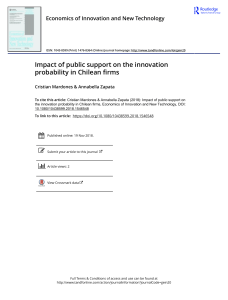
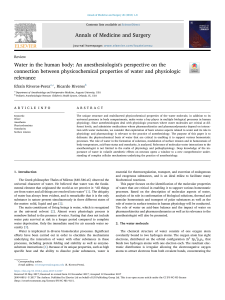


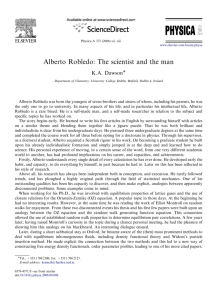
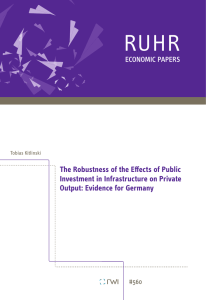

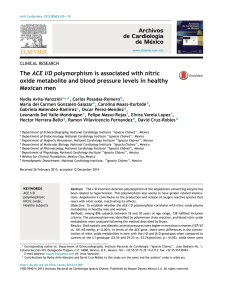


![[Myoung-jae Lee] Micro-Econometrics for Policy, Pr(BookFi)](http://s2.studylib.es/store/data/009050455_1-b46867032a881a39b32fae19b7a60af1-300x300.png)